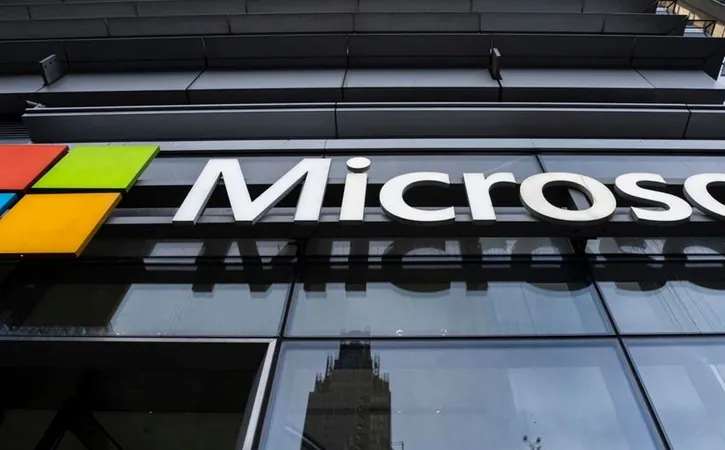
Microsoft Sounding the Alarm: 1 Billion Users to Say Goodbye to Passwords!
2025-01-21
Author: Kai
Microsoft's Bold Move Away from Passwords
As the digital landscape evolves, Microsoft has announced what could be the end of the password era for approximately one billion users. 'Bad actors are aware of this transition,' warns the tech giant, emphasizing the urgency to mitigate password-related security threats. With Microsoft currently blocking around 7,000 password attacks every second—a staggering increase from last year—it’s clear that the stakes are high.
Introduction of Passkeys
So, what's next? Microsoft aims to phase out traditional passwords entirely, introducing passkeys as a more secure alternative. These passkeys facilitate quicker logins via biometrics like facial recognition or fingerprints, eliminating common issues associated with passwords, such as forgetfulness or security vulnerabilities linked to weak or recycled passwords.
Challenges Ahead
However, a smooth transition to this new system won't be without hurdles. The United Kingdom's National Cyber Security Centre (NCSC) recently issued a cautionary note regarding the challenges that lie ahead in fully adopting passkeys. As we step towards a password-free future, various obstacles must be tackled.
User Adoption Disparities
Since their inception, passkeys have gained traction, with a reported 50% increase in awareness according to the FIDO Alliance. Despite this, user adoption appears to be split—those who are adopting the technology are doing so extensively, while many remain hesitant, raising questions about the overall readiness of the consumer base.
Ten Barriers to Transitioning to Passkeys
The NCSC outlines ten significant barriers that could hinder a mass transition to passkeys:
1. Inconsistent Experiences
With multiple versions of passkeys available, compatibility challenges arise, complicating user experiences and implementation for service providers.
2. Device Loss Anxiety
Users worry about losing access to their passkeys if their devices are lost or broken, prompting a need for robust recovery strategies.
3. Migration Difficulties
While passkeys are designed to be long-term solutions, moving them across different platforms is currently complicated, which raises concerns about their flexibility.
4. Account Recovery Vulnerabilities
As attackers increasingly exploit account recovery processes, these systems must become fortified to uphold the security advantages of using passkeys.
5. Platform Variability
Disparities in terminology and processes across different platforms might confuse and deter users from fully embracing passkeys.
6. User Access Issues
Passkeys assume exclusive device access by users, which may not hold true in shared devices or account scenarios.
7. Implementation Challenges
Providing passkey support across multiple domains can lead to confusion, necessitating a streamlined approach for users.
8. Lack of Consensus
Differing opinions on implementing passkeys in sign-in protocols may lead to inconsistencies and user frustration.
9. Multi-factor Confusion
As the industry grapples with which variations of passkeys qualify as multi-factor authentication, clarity will be crucial.
10. Security of Shared Passkeys
There is hesitance surrounding the security of passkeys that can be synced and shared, especially for sensitive accounts.
Collaborative Efforts Towards a Passkey Future
Despite these challenges, collaborative efforts between the FIDO Alliance, tech companies, and industries focused on security aim to establish a cohesive strategy for a passkey-based future. Microsoft is taking a measured approach to this shift, conducting extensive user studies to understand the best methods for onboarding users onto the new system.
The Vision Going Forward
Microsoft’s ultimate vision is ambitious: to eliminate passwords entirely and create accounts that are secure against phishing attacks. 'While moving towards passkeys is a critical step,' the company notes, 'it's only the beginning. Even with a billion users enrolled, any accounts allowing both passkeys and passwords remain vulnerable to phishing attempts.'
Conclusion
As we edge closer to a password-less era, users are encouraged to stay informed and prepared for this significant change in online security. It's a game-changer that may redefine the way we authenticate our digital identities.
Stay Tuned!
Stay tuned for more updates on this evolving story!




 Brasil (PT)
Brasil (PT)
 Canada (EN)
Canada (EN)
 Chile (ES)
Chile (ES)
 Česko (CS)
Česko (CS)
 대한민국 (KO)
대한민국 (KO)
 España (ES)
España (ES)
 France (FR)
France (FR)
 Hong Kong (EN)
Hong Kong (EN)
 Italia (IT)
Italia (IT)
 日本 (JA)
日本 (JA)
 Magyarország (HU)
Magyarország (HU)
 Norge (NO)
Norge (NO)
 Polska (PL)
Polska (PL)
 Schweiz (DE)
Schweiz (DE)
 Singapore (EN)
Singapore (EN)
 Sverige (SV)
Sverige (SV)
 Suomi (FI)
Suomi (FI)
 Türkiye (TR)
Türkiye (TR)
 الإمارات العربية المتحدة (AR)
الإمارات العربية المتحدة (AR)